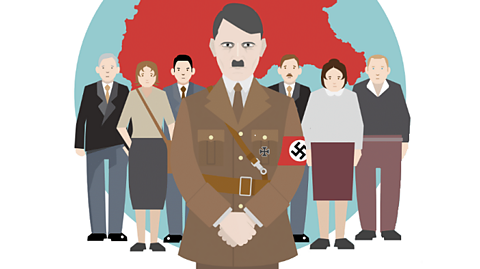Key points
In 1933, there were communities of Jewish people living in every European country.
Before 1933, German Jews were largely assimilationTo be fully integrated into a system or society. In 1933, Jewish people were mostly an accepted and welcome group in German society. into German society.
There was huge diversity across European Jewish communities in terms of culture, political views, language and religious practices.
Jewish life in Europe: Middle Ages - 1900s
Jewish people had lived in Europe since the ancient period, during which their communities lived mainly in Greece and the Mediterranean. Over time, for a range of different reasons, Jewish people had settled all over Europe. As these communities were located all over the continent, there was lots of diversity in terms of culture, language and history.
Jewish people suffered antisemitismHostility or prejudice towards Jewish people. persecutionTreating people poorly based on their political beliefs, race, religion or sexuality. throughout the Middle Ages and beyond. Antisemitism did not emerge for the first time when the Nazis took power in 1933. Jewish communities were always a minority of the population, which made them a target for persecution.
The Jewish community in England was expelTo force a person or group of people to leave a country or organisation. in 1290, and the persecution of European Jews got worse during the medieval period. Jewish communities in eastern Europe also suffered extreme violence and persecution in the last decades of the rule of the Russian TsarsThe monarchs of Russia, who ruled prior to the revolution of 1918., whose time in power came to an end in 1917. This led many to leave Europe altogether, with large numbers of Jewish people moving to the USA. Others moved to western European countries, including Britain, Germany and France.
Map - The Jewish population in pre-war Europe
Jewish life in Europe by 1933
When Hitler came to power in 1933, there were communities of Jewish people living in every European country. These communities were very diverse, with people having lots of different political opinions, cultures and differences in how they practiced their religion.
In total, there were approximately 9.5 million Jewish people living in Europe.
The largest Jewish communities were in eastern Europe, with more than 3 million Jews living in Poland, more than 2.5 million in the Soviet Union and 980,000 in Romania.
Photos of Jewish life in pre-war Europe
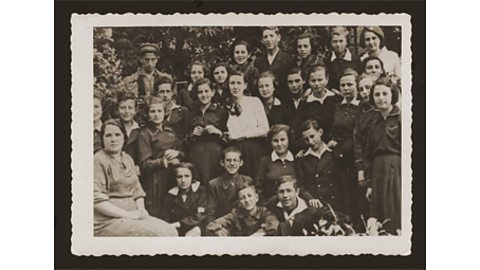
Image caption, A group portrait of students at the Jewish gymnasium (secondary school) in Zamosc, Poland. Copyright: United States Holocaust Memorial Museum. Provenance: Mahli Lieblich.
Image caption, A family poses for a photograph outside their home in Poland on the eve of Shauvot, one of the Jewish harvest festivals. Copyright: United States Holocaust Memorial Museum. Provenance: Paul Halter.
Image caption, Children celebrate a birthday party in Paris, France. Copyright: United States Holocaust Memorial Museum. Provenance: Willy Fogel.
Image caption, A couple and their son sunbathe on the beach in Poland. This photograph was taken shortly before the Nazi invasion of Poland. Copyright: United States Holocaust Memorial Museum. Provenance: George Oscar Lee.
Image caption, Children from the Jewish nursery school in Kaunas, Lithuania, pose for a photo in the snow. Copyright: Public Domain. Source: Association for the Lithuanian Jews in Israel.
Image caption, A portrait of the Wijnberg family from Groningen, Holland. Copyright: United States Holocaust Memorial Museum. Provenance: Selma Wijnberg Engel.
1 of 6
In Poland, Jewish people represented more than 10% of the total population. Many Polish Jewish communities, particularly in more rural areas, were very religious. Many were very poor.
As the Jewish population of Poland was so large, its communities made a huge contribution to Polish life and culture.
There were thriving Jewish political parties, newspapers, magazines and theatres. Many Polish Jews, particularly in Warsaw, spoke Yiddish, a language that combined elements of German and HebrewThe language of the Torah, the Jewish Holy Book, which is spoken by Jews around the world. It is also the national language of the modern state of Israel.. Poland was home to 15 Yiddish theatre troupes, and a number of Yiddish-language films and newspapers were produced. The Main Judaic Library, which collected materials on the history of Jewish communities, was located in Warsaw. Jewish writers, such as Bruno Schulz, had a significant impact upon Polish culture.
How many Jewish people lived in Britain in 1933?
In Britain, there were approximately 300,000 Jews in 1933, who were largely assimilated into British society.
The British Union of Fascists was founded in 1932, and they voiced antisemitic views. In 1936, when they tried to march through Londonтs East End, the Jewish community and its allies blocked the streets. The violence that erupted became known as the Battle of Cable Street. This was a significant show of opposition towards fascist views, and the party never achieved electoral success of any note.
Jewish life in Germany before 1933
Before Hitler became ChancellorThe leader in the Reichstag, appointed by the German President. of Germany in 1933, many Jews were assimilationTo be fully integrated into a system or society. In 1933, Jewish people were mostly an accepted and welcome group in German society. into German life.
There were approximately 500,000 Jews living in Germany by 1933, representing just 1% of the total population. Jewish people worked in a range of different professions and came from all sorts of backgrounds. Some had married non-Jews, and some had prominent roles in their communities, such as doctors, lawyers, business owners and politicians.
During World War One, 100,000 Jewish people had fought for the German army. 12,000 lost their lives.
The Nazis tried to categorise all Jewish people as the same, but this wasnтt the reality. Many Jews identified themselves as German first and foremost. Lots of Jewish people were secular, which meant that they were not actively practicing their religious faith.
Photos of Jewish life in pre-war Germany
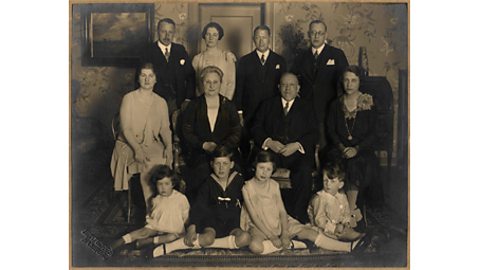
Image caption, A family portrait taken during the 70th birthday party of Leo Stern, who is sitting in the middle row, second from the right. Copyright: United States Holocaust Memorial Museum. Provenance: Monica Luke.
Image caption, Liese and Siegbert Einstein play toy instruments in the garden of their home in Augsburg. Both children were sent to England on the Kindertransport in July 1939. Copyright: United States Holocaust Memorial Museum. Provenance: Liese Fischer.
Image caption, Berta Rosenhein dressed in a costume for her school play in Leipzig. Copyright: United States Holocaust Memorial Museum. Provenance: Berta Rosenheim Hertz.
Image caption, Twins Leo and Celia Petranker play outside on the pavement in Berlin. Copyright: United States Holocaust Memorial Museum. Provenance: Amalie Petranker Salsitz.
Image caption, A portrait of children who were members of the Hakoach sports club in Essen. Copyright: United States Holocaust Memorial Museum. Provenance: Henry Straus.
Image caption, Bride and groom Margot Levi and Paul Weinschenk with their wedding guests in Stuttgart. Copyright: United States Holocaust Memorial Museum. Provenance: Carol Weinschenk Opton.
1 of 6
Many German Jews had achieved great success and held prominent positions in Germany before 1933:
Richard Martin WillstУЄtter won the Nobel Prize for Chemistry in 1915.
Walther Rathenau worked for the German government during World War One and played a key role in managing the supply of raw materials. He became German foreign minister in 1922. He was assassinated by an antisemitic terrorist organisation after signing the Treaty of Rapallo.
Albert Einstein, who won the Nobel prize for Physics in 1921. James Franck also won this prize, in 1925.
Victoria Wolff was a journalist and successful novelist.
Jewish Germans made a significant contribution to the cultural life of pre-war Germany. In 1925, Julius Goldstein founded Der Morgen, a literary magazine that published articles on a very varied range of topics, including philosophy, history, politics and religion. The magazine also featured writing by important Jewish authors, such as Franz Kafka.
Antisemitism in pre-war Germany
Though Jewish people were largely assimilated in Germany in 1933, there had been cases of antisemitism in the years before the Nazis came to power. As the Jewish community was such a small minority of the German population, it was a target for persecution.
At the end of World War One, some in Germany, seeking a scapegoatA person or group of people who is unfairly blamed for the mistakes or failures of others. for their nationтs military loss, wrongly blamed Jews for the defeat. They falsely claimed that the army had been тstabbed in the backт by a government that was being controlled by Jews. They called the government the тNovember Criminalsт for their unconditional surrender on 11 November 1918. This feeling was made worse following the signing of the Treaty of Versailles in 1919, which heavily punished Germany for their defeat in the war.

Image caption, Content warning: The following image is an antisemitic cartoon. It contains highly offensive imagery
Image caption, This antisemitic cartoon, taken from an Austrian postcard produced in 1919, was made as part of the entirely false тstabbed in the backт theory. The figure on the right holding a knife is a highly offensive representation of a Jewish person, and the soldier represents the German army. The cartoon uses this offensive imagery to wrongly suggest that Jewish people were responsible for the defeat of the German army during World War One.
1 of 2
Test your knowledge and inference skills
Question 1
Take a look at the photograph below.It shows a German married couple, Karl Johann and Johanna Leopold Keummel. Johanna was Jewish, and Karl was not. What does this marriage between a Jewish and non-Jewish person tell you about life in Germany during the 1920s?
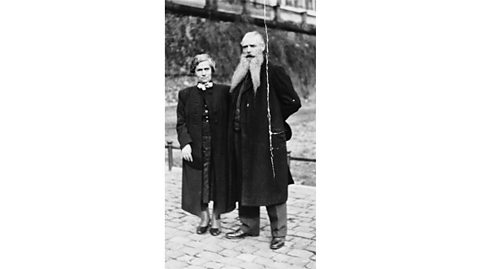
Marriages between Jewish and non-Jewish people tell us that there were high levels of assimilation of Jews in Germany.
Many people saw themselves as German first and Jewish second.
Mixed marriage was increasingly common before the Nazis came to power. In Hamburg in 1933, 57% of all Jewish weddings were between a Jewish and non-Jewish person.
Question 2
Take a look at the photograph below, of a ballet class in Romania. What can you infer about Jewish life in pre-war Europe from this picture?
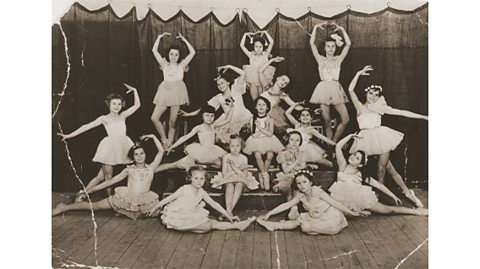
The children in this photo look happy, and it seems that they enjoy being part of their ballet class.
It looks like the group might be about to put on a show, maybe for their parents and families.
It is not certain that all of the children in this photograph are Jewish. From this, we can infer that Jewish and non-Jewish communities took part in activities together in pre-war Europe.
The gave advice and guidance during the production of this guide.
Play the History Detectives game! gamePlay the History Detectives game!
Analyse and evaluate evidence to uncover some of historyтs burning questions in this game.

More on World War Two and the Holocaust
Find out more by working through a topic
- count8 of 10

- count9 of 10

- count10 of 10

- count1 of 10
